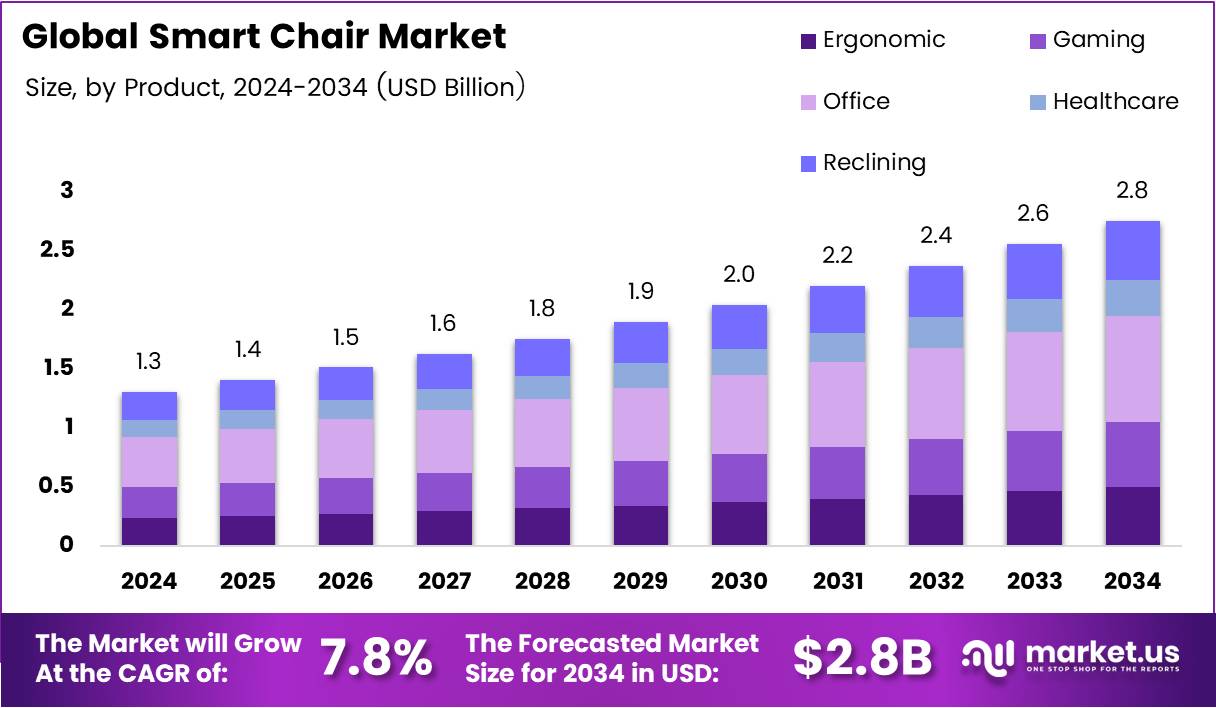Table of Contents
Introduction
The global smart chair market is experiencing significant growth as organizations and households increasingly prioritize ergonomic comfort and connected living environments. With the integration of IoT, sensors, and AI-driven features, smart chairs are transforming how individuals interact with seating in work and relaxation settings.
Moreover, the rapid shift toward remote and hybrid working models has elevated the demand for intelligent seating solutions designed to enhance posture, reduce fatigue, and improve overall wellness. These advancements are reshaping both corporate workspaces and residential environments, contributing to market expansion.
Additionally, rising awareness of musculoskeletal health and government initiatives promoting workplace safety are further stimulating adoption. As smart homes and digital work environments continue evolving, smart chairs are positioned as essential components of modern ergonomic and wellness-focused living.

Key Takeaways
- The Global Smart Chair Market is valued at USD 1.3 Billion in 2024 and projected to reach USD 2.8 Billion by 2034, growing at a CAGR of 7.8% during 2025–2034.
- Office chairs lead the market by product with a 32.8% share in 2024, driven by rising adoption in corporate environments.
- Residential applications dominate by application with a 26.9% share in 2024, supported by smart-home integration trends.
- North America holds the largest regional share at 43.8%, valued around USD 0.5 Billion in 2024.
Market Segmentation Overview
Office chairs account for the largest share due to widespread implementation in corporate work environments. Their advanced ergonomic design, posture-correction features, and connectivity options make them ideal for promoting employee health and productivity across diverse organizational structures.
Ergonomic smart chairs are gaining increased traction among health-conscious consumers. These chairs provide customizable lumbar support, pressure monitoring, and personalized comfort adjustments, making them suitable for home offices and professional workstations focused on long-term wellness.
Gaming smart chairs continue to expand as the popularity of eSports and streaming grows. These chairs offer immersive features, including vibration feedback, temperature regulation, and extended-use comfort enhancements designed to support prolonged gaming sessions.
Healthcare-oriented smart chairs are evolving continuously, supporting hospitals, rehabilitation centers, and eldercare environments. Their integrated vital tracking and adaptive posture support technologies enhance patient safety and recovery outcomes.
Reclining smart chairs are increasingly sought after in residential and luxury hospitality settings. With voice control, intelligent massage modes, and smart home synchronization, these chairs serve as premium comfort solutions for relaxation and entertainment spaces.
Drivers
Rising Focus on Ergonomic Wellness: Growing awareness of posture-related health issues, including lower back pain and musculoskeletal disorders, is driving demand for smart seating. Companies and individuals are increasingly investing in intelligent chairs that actively monitor posture and provide feedback to improve sitting habits.
Expansion of Remote and Hybrid Work Models: As more individuals work from home, the need for ergonomic home-office furniture has surged. Smart chairs that adapt to user movements and offer real-time posture correction support productivity and long-term comfort, making them essential for hybrid work lifestyles.
Use Cases
Corporate Workspaces: Organizations adopt smart chairs to reduce employee fatigue, enhance focus, and mitigate workstation-related health issues. Smart chairs integrated with analytics tools can also help employers design better occupational wellness programs.
Home Offices and Gaming Rooms: Remote professionals and gamers benefit from customizable comfort settings that adapt to prolonged activity sessions. Smart chairs offer tailored support, improving both performance and health management at home.
Major Challenges
Privacy and Data Security Concerns: Smart chairs collect personal data related to body movement and posture patterns. Users and organizations express concerns about data protection, creating barriers to adoption without robust privacy frameworks.
High Initial Cost of Smart Seating Solutions: Advanced sensors, AI integration, and intelligent system controls increase production costs. This leads to premium pricing, which may limit adoption in budget-sensitive markets.
Business Opportunities
Integration with Smart Home Ecosystems: Expanding compatibility with platforms such as Google Home and Amazon Alexa presents opportunities to enhance user convenience and expand market reach among tech-savvy consumers.
Growth in Digital Healthcare and Rehabilitation: Smart chairs with posture monitoring and patient mobility data can support telemedicine and remote physiotherapy. This creates new partnership opportunities with clinics, hospitals, and wellness programs.
Regional Analysis
North America: With a market share of 43.8%, North America leads due to strong adoption of ergonomic office furniture, widespread remote work models, and high consumer awareness of wellness technology. Advanced manufacturing capabilities and early adoption of IoT solutions further strengthen regional growth.
Asia Pacific: The region is projected to experience the fastest growth, driven by urbanization, rising disposable incomes, and increasing demand for smart home integration. Countries like China, Japan, and India are investing heavily in enterprise workspace modernization and intelligent lifestyle products.
Recent Developments
- In August 2025, HNI Corporation announced a strategic deal to acquire Steelcase Inc. for about USD 2.2 billion, strengthening its position in the global office furniture market.
- In July 2024, BackRobo introduced the Air Smart Chair (C2) with AI-driven ergonomic adjustments and smart lumbar support features designed for contemporary work environments.
Conclusion
The smart chair market is poised for substantial growth driven by rising ergonomic awareness, digital transformation of workplaces, and expanding smart home ecosystems. As companies and consumers continue prioritizing health, comfort, and connected living, innovations in smart seating will accelerate. Manufacturers who focus on personalization, sustainable materials, and integrated intelligence are well-positioned to benefit from the evolving demands of modern lifestyles.
Discuss your needs with our analyst
Please share your requirements with more details so our analyst can check if they can solve your problem(s)



